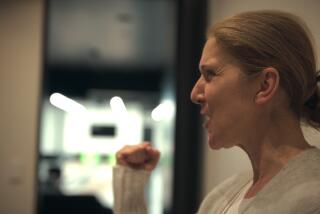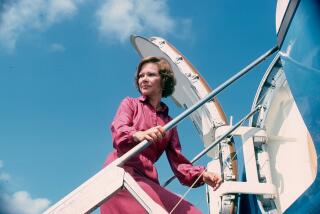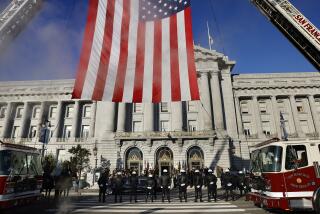That Instinctive, Enigmatic Aplomb
- Share via
People no longer came up to Jacqueline Kennedy Onassis on the street and asked impertinent questions, said society columnist Liz Smith last Thursday night. And if they did, said Smith, Jackie “just smiled and went on her way.” She had finally become what she had perhaps always wanted to be: a famous, private person.
She had managed it by learning to handle people and the press like no one else ever has--silently. Her dictum to her secretary (“My press relations will be minimum information given with maximum politeness.”) had been reduced even more, to a brief, enigmatic smile.
It hadn’t always been so easy. At the Democratic National Convention in 1956, Jacqueline Kennedy was sitting in the Kennedy box when a reporter approached her. At the word newspaper , Jackie jumped up, left the box and headed across the convention floor. The reporter followed. She ducked down a hallway leading to a garage. The reporter kept after her. She hiked up her skirt, broke into a run and disappeared. Four years later, there was nowhere to disappear to: At age 31, she was the First Lady. Nancy Reagan says that nothing--in her case, not the years in Hollywood and in the California governor’s mansion combined--can prepare one for the absolute crush of public/media interest in those who inhabit the White House. And Nancy Reagan was no Jackie Kennedy.
This was the woman who so impressed the French on a state visit that John F. Kennedy said, “I don’t think it impertinent to introduce myself; I’m the man who accompanied Jacqueline Kennedy to Paris.” This was the woman who, after giving speeches in Spanish in Latin America, caused Che Guevara to say that she was the only American woman he wanted to meet--and he didn’t want it to be at a conference table. This was the woman who received, on average, 10 press requests a day for her shoe size.
This was also the woman who feuded constantly with the intrusive press, particularly when her children’s privacy was concerned. (Even her husband waited until she was out of the country to arrange the now-famous photographs of Caroline and John Jr. under his desk.)
This, on the other hand, was the woman who directed the greatest theatrical event in modern history--Kennedy’s funeral. She more than anyone seemed to instinctively understand that, in terms of the collective consciousness if not politics, the assassination left the world not with Lyndon B. Johnson but with Jackie, Caroline and John-John. This was the moment that her and the kids’ lives were unquestionably, importantly public. This was history and healing combined, for family and country.
She single-handedly created an entire portfolio in America’s iconic imagery: standing beside Johnson as he was sworn in; walking behind the horse-drawn coffin and between the two brothers; she and Caroline kneeling before and kissing the flag-draped coffin; John-John saluting his father one last time, and finally, her own veiled grace cracking over the grave.
On a basic level, we liked looking at Onassis. She was stunning and, even at her worst, photographed well. Among the panoply of images moving across our TV screens since her death were some that took our breath away. Her nature, her silence, was such that we could never get enough of her. We were always left yearning for more. A novelist once told me he never fully describes his female characters physically, because readers like to fill in the blanks. Onassis was like that, only she was the visual counterpart, and we were always filling in her words, her thoughts. She was what we wanted, who we hoped she would be.
There were, of course, things we knew--or thought we knew--about her, things we liked and disliked, sometimes simultaneously. With an instinctive aplomb and grace, mixed with a willful independence, she consistently defied expectations--official and otherwise. Early on in the White House years, she boasted to a friend, “People told me 99 things I had to do as First Lady--and I haven’t done one of them.”
One of them was cooperating with the press. Jackie not only didn’t cooperate, she didn’t care. She skipped a press luncheon once, feigning illness, and spent the afternoon touring the National Gallery with the novelist Andre Malraux, then France’s minister of culture. So she irritated a few reporters. So what? In the end, she spent the afternoon with Malraux, and they didn’t.
That enigmatic smile? Now you know.
More to Read
Get the L.A. Times Politics newsletter
Deeply reported insights into legislation, politics and policy from Sacramento, Washington and beyond. In your inbox twice per week.
You may occasionally receive promotional content from the Los Angeles Times.










